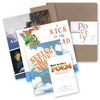Exploring Poetry: A Journey Through the Forms and Fundamentals of Poetry is great for those ready to dedicate time and attention to the study of poetry with older students. It presents a seven-week exploration of poetry in sort of a unit study approach for students in grades five through twelve.
The Exploring Poetry bundle includes a guide/worktext, three supplemental books (of and about poetry), a set of art cards, and a journal. The course guide/worktext is a 68-page binder that explains the use of the other resources. It can be used for independent study or in combination with a group class meeting. Very brief instructions are written directly to the student. An answer key at the back may easily be removed if parents want to keep it separate.
Learning is more of a discovery process rather than reading what others think about poetry and particular poems. Students read poems, make their own observations, and write in the guide/worktext, but the process is directed each step of the way by questions and brief directions. For example, a lesson might direct a student to read a poem, select a stanza, and explain what it means in the student’s own words. Students practice writing elements of poetry such as similes and metaphors as well as their own poems.
The guide teaches students to read a poem for both appreciation and inspiration. I like the approach it uses: teaching by first inspiring, then instructing. For example, observing how a skillful author uses personification to reveal an unusual aspect of an inanimate object becomes a stepping stone for the student to create his or her own personifications. In learning about the “ode” form of poetry, students read Gary Soto’s “Ode to Pablo’s Tennis Shoes” that ends with the delightful image:
He needs eight hours
Of sleep
To cool his shoes,
The tongues hanging
Out, exhausted.
Students are then instructed to, “Write three phrases that might be included in an ode to pencils” (from the resource book, A Kick in the Head, p. 35).
Exploring Poetry’s purpose—“to discover the craft of writing poems and to delight in the reading of poetry”—is accomplished in a way that should appeal even to the poetry-phobic student.








